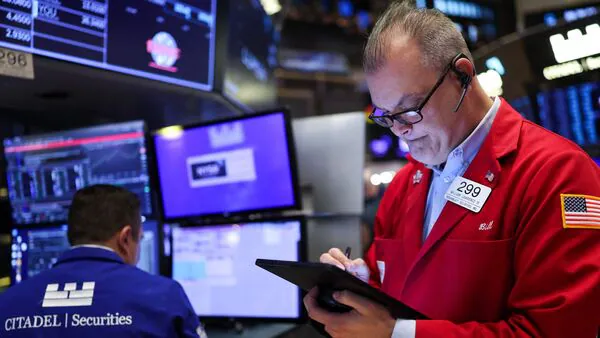Market Rollercoaster: S&P 500 Plunges 2.3% as Trade Fears Eclipse Positive Inflation Data
The U.S. stock market weathered another day of whiplash this week, highlighting the tenuous equilibrium between economic optimism and geopolitical unease. On Thursday, the S&P 500 fell 2.3%, wiping out part of its record 9.5% gain just 24 hours before—a rally triggered by President Donald Trump’s declaration of a temporary tariff reprieve. The sudden about-face, driven by renewed trade war jitters, underscored investors’ fragile confidence in an environment where policy headlines and macroeconomic data converge.

A Historic Surge Meets a Swift Reversal
Wednesday saw markets have one of their best days in decades. The S&P 500 soared 9.5%, its third-biggest single-day increase since 1940, following an announcement by the Trump administration to freeze tariffs on targeted trading partners. The Dow Jones Industrial Average and Nasdaq Composite followed the rally, rising 8.7% and 9.3%, respectively. Investors took the pause on tariffs to mean possible de-escalation of the world trade war, which has damped corporate profits and ruffled supply chains since 2018.
“The market’s response was euphoric but premature,” said Diane Swonk, chief economist at Grant Thornton. “Tariff relief is a Band-Aid, not a cure.”
By Thursday morning, the optimism had dissipated. The S&P 500 fell 2.3%, the Dow lost 685 points, and the Nasdaq declined 2.9%, as fears about how long the tariff truce would last gained traction. The sell-off highlighted a brutal reality: in the markets of today, geopolitical uncertainty usually prevails over even the most rosy economic news.
The Inflation Report: A Silver Cloud with a Dark Lining
Ironically, the Thursday decline happened together with a bullish inflation report. The October Consumer Price Index (CPI) reported that core inflation (ignoring flailing food and energy prices) increased only 0.2% month to month, short of the forecasted 0.3%. Core inflation on a year-over-year basis was at 2.3%, as desired by the Federal Reserve and dispelling fear of reckless rate hikes.
This is precisely what the Fed would like to see—controlled inflation without overheating,” said James Knightley, chief international economist at ING. Lower inflation generally supports equities by lowering borrowing costs and underpinning consumer spending. But on this day, traders shrugged it off.
Why the disconnect?
- Trade War Overhang: Investors prioritized the risk of tariff reinstatements over stable inflation.
- Sector Sensitivity: Tech stocks, which dominate the Nasdaq, are disproportionately exposed to trade tensions due to global supply chains.
- Sentiment Whiplash: Markets often overcorrect on short-term headlines, reflecting algorithmic trading and herd mentality.
Trade Wars: The Ghost Haunting Wall Street
The U.S.-China trade war, renewed in 2023 with tit-for-tat tariffs on semiconductors and electric cars, has already cost the S&P 500 an estimated $1.5 trillion in market value. Though Trump’s tariff hiatus brought relief, doubt persisted.
Key concerns driving Thursday’s selloff:
- Unresolved Issues: The tariff “pause” lacked details on long-term solutions for intellectual property disputes or subsidies.
- Retaliation Risks: China’s Commerce Ministry warned of “necessary measures” if the U.S. resumed tariffs.
- Supply Chain Chaos: Companies like Apple and Tesla, reliant on Chinese manufacturing, remain vulnerable to disruptions.
“Trade wars are easy to start but hard to end,” remarked former Fed Chair Alan Greenspan. “Markets are pricing in perpetual uncertainty.”
Sector Spotlight: Tech Takes the Brunt
The Nasdaq’s 2.9% decline outpaced larger indexes, illustrating tech’s disproportionate exposure to international trade. Chip companies such as Nvidia and AMD dropped 4% and 5%, respectively, as investors worried about fresh export restrictions. Even Apple, which recently relocated iPhone manufacturing to India, dropped 3.2% amid fears of Chinese consumer backlash.
Meanwhile, defensive sectors like utilities and consumer staples outperformed, albeit marginally. “In volatile times, investors flock to stability,” said Lisa Shalett, Morgan Stanley Wealth Management’s CIO.
Historical Parallels: Echoes of 2018
The turbulence now reflects the 2018–2019 trade war, when the S&P 500 wildly fluctuated on tariff news. Then, the index saw 20 1%-plus swings in one month, leading to a 19.8% Q4 2018 decline.
Key differences today:
- Higher Stakes: Tariffs now target critical technologies, not just soybeans and steel.
- Global Recession Risks: The IMF warns that prolonged tensions could shave 1.5% off global GDP by 2025.
- Fed Policy: Unlike 2018, the Fed is now cutting rates, complicating its inflation mandate.
Expert Insights: Navigating the Storm
Analysts remain divided on the path forward:
- Optimists: “The tariff pause is a step toward détente. Markets will stabilize as dialogues progress,” argues Goldman Sachs’ David Kostin.
- Pessimists: “This is a dead-cat bounce. Without a concrete deal, selloffs will intensify,” warns JPMorgan’s Marko Kolanovic.
The CBOE Volatility Index (VIX), Wall Street’s “fear gauge,” surged 18% on Thursday, reflecting heightened anxiety.
What’s Next? Key Signals for Investors
- Trade Negotiations: Watch for U.S.-China talks in November. Progress could reignite rallies.
- Fed Guidance: Chair Jerome Powell’s next speech may hint at rate cuts if trade risks escalate.
- Earnings Reports: Q3 results from retailers like Walmart will reveal tariff impacts on consumer prices.
The Delicate Dance of Data and Drama
Thursday’s market drop highlights a bitter truth: in an age of geopolitical gamesmanship, even excellent economic news can be trumped by the threat of war. For investors, the message is unmistakable—diversification and caution are essential. As trade war anxiety and inflation reports continue their game of tug-of-war, the only guarantee is volatility.
Click Here to subscribe to our newsletters and get the latest updates directly to your inbox.

